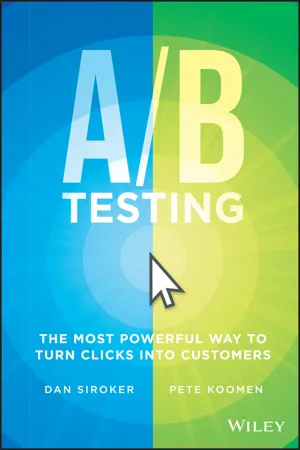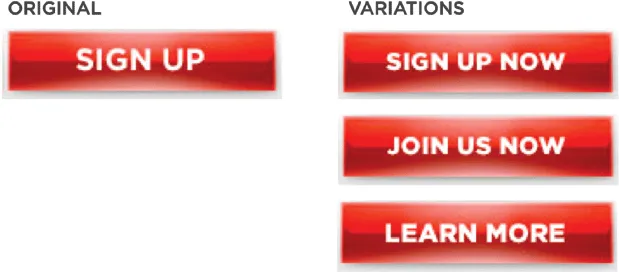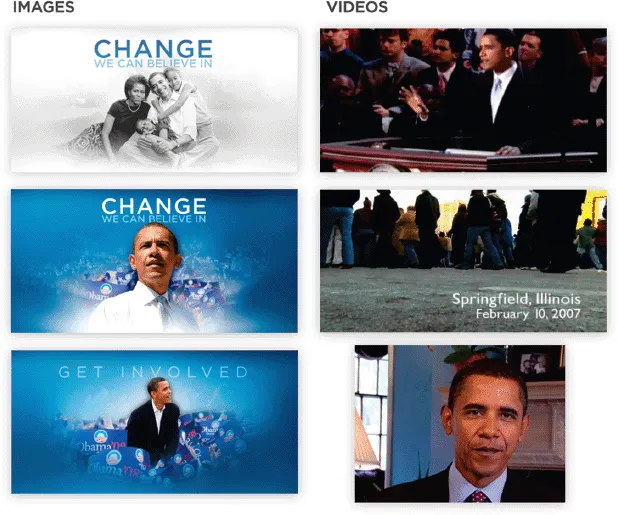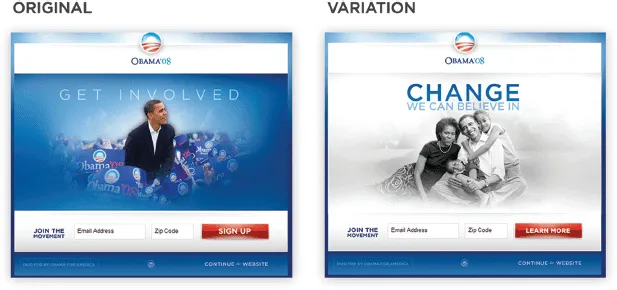![]()
Chapter 1
How A/B Testing Helped Win the White House—Twice
The $57 Million Button
It was 2007 when then-Senator Barack Obama was running for President, and no one but the Des Moines Register seemed to think he had a chance of winning the Democratic primary.
DAN: I was a product manager at Google at the time, and I'd seen Obama speak at our headquarters several weeks prior to the primary election. “I am a big believer in reason and facts and evidence and science and feedback—everything that allows you to do what you do. That's what we should be doing in our government,” Obama told the packed auditorium. “I think that many of you can help me, so I want you to be involved.” He probably meant that he wanted donations, or maybe votes, but I took him literally. I took a leave of absence from Google initially and eventually quit my job to move from California to Chicago to join the campaign.
I joined what was being called the “new media” team. They used the phrase “new media” because it encompassed everything that didn't typically fit into traditional political campaigns: email, social media, blogging, SMS, and the web. The team had competent bloggers, designers, and email copywriters; I wondered where I might be able to make an impact.
One thing stood out to me: a red button.
Online donations to the campaign came from subscribers to the email newsletter; subscriptions for this came from the campaign website's signup form; and the signup form came as a result of clicking a red button that said “Sign Up.” This was the gateway through which all of Obama's email supporters had to pass; it all came down to one button. So, one simple, humble question immediately became pivotal.
Is This the Right Button?
Is this our best chance to get every single supporter, and every single dollar, that we possibly can?
I had zero political experience at the time, and little clout within the organization. I didn't have a politico's intuition about what the button or the image above it should look like—nor the persuasive rhetoric required to run any proposed improvements up the chain of command. All I had was one insistent question: Is this button the absolute best? —and the desire to find the answer. There was only one way to know for certain.
Knowing little about politics or why certain words and images might be more moving or more effective than others, I suggested experimenting to figure out what worked to drive the most signups. Our team tested four different labels for the button (“Sign Up,”“Sign Up Now,”“Join Us Now,” and “Learn More”) and six different media (images and videos) above it to see which combination induced the most visitors to engage and sign up.
Our team took bets on which variation (Figures 1.1 through 1.3) would perform best at garnering email signups. Most folks put their money on “Sam's Video,” a compilation of some of the most powerful moments in Obama's speeches. We assumed any video—with not just Obama's image, but his voice and message—would lead more people to enter their email addresses than a simple static image would.
Boy, were we wrong.
In fact, not only “Sam's Video” but every video dramatically underperformed every image. Even more dramatically, one image-and-button combination in particular stood head and shoulders above the original (Figure 1.4).
A combination of the “Family Image” and the “Learn More” button improved the signup rate by a staggering 40.6 percent. Over the course of the campaign, that 40.6 percent lift in signups translated to 2.8 million more email subscribers, 288,000 more volunteers, and—perhaps most important of all—an additional $57 million in donations.
Obama went on, with an enormous lead in dollars and supporters raised online, to win the election. He was buoyed by a team willing to test everything and to listen to the data even when it surprised them the most.
A small, simple question about a small red button had been answered conclusively with a straightforward experiment. But in its place loomed another question, just as simple and just as insistent:
“Why aren't more people doing this?”
The Age of Testing
The answer, in short, was that the commercially available tools at the time required heavy involvement from software engineers to run experiments. For all of the spectacular gains that website testing enabled at the Obama campaign—as well as at big-tech players like Google and Amazon—it was still a highly technical practice. It was simply out of reach for most businesses that didn't have the know-how and a dedicated in-house team, and prohibitively difficult even for many that did. But why did this have to remain the case? Why couldn't every organization have access to these tools?
I joined up with my fellow Google product manager, Pete Koomen, and in 2010 the two of us struck off on our own to help do just that. What we built as a result is Optimizely, a website optimization platform that makes it easy for any organization, from a one-person startup to a Fortune 100 firm, to do what the Obama team did on the road to the White House—with no degrees in statistics or dedicated engineering team required.
Over the past several years, a range of new tools has emerged to make this online testing and optimization practice—A/B testing, as it is known—easier and faster. The concept of A/B testing is simple: show different variations of your website to different people and measure which variation is the most effective at turning them into customers. If each visitor to your website is randomly shown one of these variations and you do this over the same period of time, then you've created a controlled experiment known as an A/B test. A/B testing has gone from a secret weapon within the purview of only a handful of tech companies to an increasingly ubiquitous and critical part of doing business online.
This sea change in the way companies are conducting online business and marketing is perhaps best illustrated by taking a glance at the election cycle that came next: the 2012 presidential race. There were some key differences between 2012 and 2008: the Obama campaign team had an intense testing program in place from day one and didn't need to be persuaded as to the mission-critical value of A/B testing. The other key difference: so did the opponent, Mitt Romney.
Leading publications from TIME to The Atlantic to Businessweek to Forbes wrote about the 2012 presidential campaign fundraising machines as being the most sophisticated, data-driven, and efficient organizations that politics had ever seen. And at the heart of this new reality was A/B testing.
Optimization for Everyone
Whether or not you have plans to run for office in the near future, whether you come from a huge organization or a team of one, and whether your background is in computer science or marketing, you can make these same changes happen in your own workplace.
In this book we'll tell the story of a number of different companies—what they tested, what they learned, and how testing has grown to become part of their mindset, values, and culture. We at Optimizely have been fortunate to witness this transformation take place time and again. Part of what we want to change is the notion that testing is something that only IT staff or developers can do, because nothing could be further from the truth. Anyone can conduct A/B testing, and it can affect—and infect—an entire organization.
This book is for anyone interested in building a culture of testing within his or her organization by being curious enough, brave enough, and humble enough to ask simple questions like “Is this red button the best?” and to experiment to find the answer. Through our experiences building Optimizely and through extensive contact with our own customers, we've come to understand very well the challenges that this group faces—a group that includes the following members at its core:
- Digital marketers and marketing managers
- Designers
- Product managers
- Software engineers
- Entrepreneurs
- Copywriters
- Growth hackers
- Data scientists
No matter your role or experience level, your seniority or budget, you'll come away from this book with a host of new ideas, as well as a seasoned understanding of the challenges—and advantages—involved in using data to drive your organization's growth and revenue. To help you get going, we'll start with some of the most common questions:
“How should we choose what to test?”
“How can my team and I adopt a sustainable testing process?”
“Where do we begin?”
This book takes you through dozens of real-world examples that show specifically how teams like yours have embraced A/B testing as a fundamental part of not only their day-to-day workflow, but their creative process as well. We...




